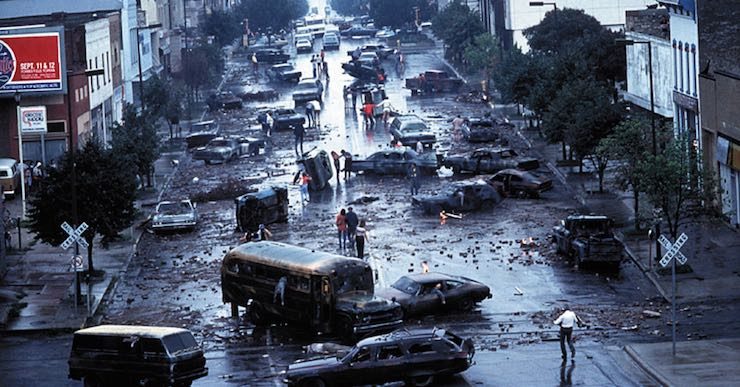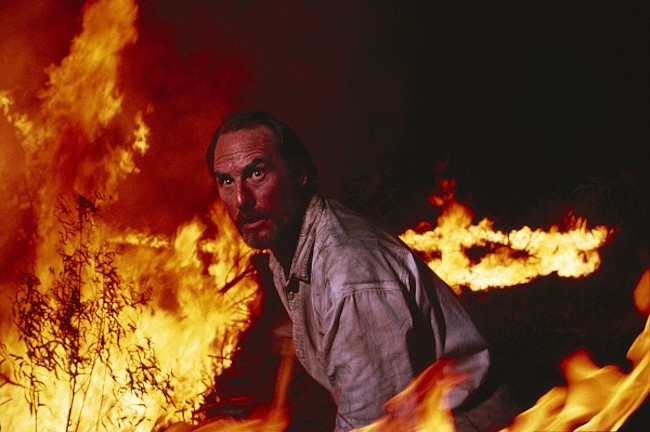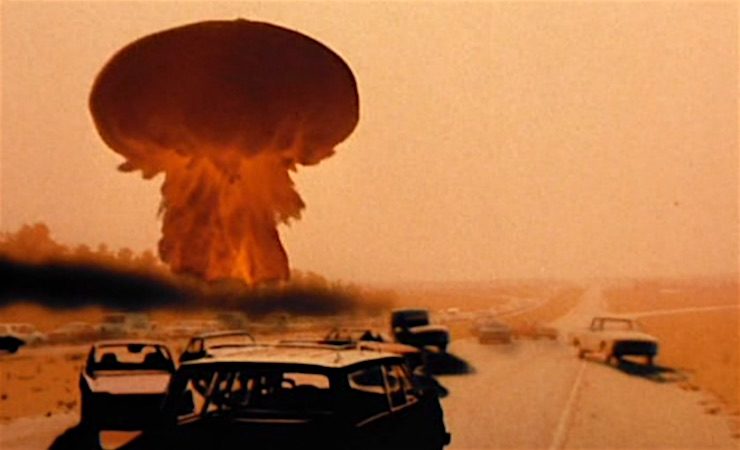All storytelling is political in some way, conveying the biases, desires, and fears of the storyteller. But then there are stories with a direct political or social message, not so much woven into the narrative, but spoken outright. When this is done effectively, it can make people rethink the way they look at the world—but when it fails, it can be painful to sit through.
There was a time when made-for-TV movies and miniseries provided a vehicle for heavy-handed, message-driven storytelling. TV movies have always been the minor league of filmmaking, especially those classified as science fiction or fantasy. Almost all of them had laughable effects budgets, with bloated narratives meant to keep viewers watching until the next commercial break. For me, two films in particular stand out, both revealing some of the dos and don’ts of inserting a Big Message into a story. The first may have literally saved the world (for real). The second is largely forgotten—which is a damn shame, given how important its message is.
Let’s start with the good one: The Day After (1983). I remember my physics teacher describing it for the class one day: “You may recall this movie because your parents made you go to bed early that night,” he said. Directed by Nicholas Meyer (Star Trek II: The Wrath of Khan), The Day After is a harrowing account of the effects of a nuclear war in the Kansas City area. For the first thirty minutes, we are introduced to a handful of ordinary people: The Dahlbergs, a family of farmers. Dr. Oakes (Jason Robards) and his team of physicians. A group of students at the University of Kansas, led by brainy Professor Huxley (John Lithgow). An airman named McCoy, stationed at Whiteman Air Force Base. In the background, as the characters discuss weddings and classes and their plans for the weekend, television sets and radios blare the alarming news: a standoff along the East German border threatens to trigger a nuclear confrontation. Even after the missiles leave their silos, streaking across the sky, many of the characters are so focused on their everyday lives that they cannot accept what is happening right in front of them.
In the second half of the film, Oakes and his team try to maintain order while dazed refugees seek shelter at their hospital. The Dahlbergs take in a hitchhiker (Steve Gutenberg), who helps them find medical care for their children. McCoy narrowly escapes the blast only to succumb to radiation sickness, while Huxley tries in vain to contact someone via radio. Each of these threads ends with the characters surrounded by chaos and destruction, the most powerful being the image of Oakes weeping in the wreckage of his former home.
There are elements of The Day After that have not aged well—namely the establishing scenes, which rely heavily on cliché and some cheesy dialogue. But, I would argue, these mundane moments make the second half so much more horrifying, a complete upheaval—perhaps even an indictment—of the oblivious “Morning in America” existence we’ve witnessed up until then.
Meyer lets the horror speak for itself. At one point, he even uses a technique reminiscent of Gone with the Wind, in which one of the characters steps into a large space filled to the horizon with the bodies of the dying. In a setting like this, there is no need for soliloquies, manufactured tension, or pedantic dialogue.
Case in point: for a film that inspired so much debate about military policy, the story itself features only a handful of brief discussions about the wisdom of nuclear deterrence. (In one of these debates, viewers might be amused by a particular actress who plays a KU student—she looks a bit like Barb from Stranger Things.) In the hospital scenes, which reminded me of The Plague by Albert Camus, Oakes struggles to stay focused with so much death and carnage around him. When asked why he keeps going, he responds not with some flowery speech, but with a simple, “I don’t know.”

Perhaps most important is the way Meyer refuses to let the audience off the hook with some tacked-on message of hope. Characters die unceremoniously, from Farmer Dahlberg’s senseless murder to Nurse Bauer’s (JoBeth Williams) off-screen death, mentioned only in passing as if to indicate how commonplace such news has become. Even after that awful last scene, a title card points out that a real nuclear war would be far more catastrophic than the events we have just witnessed. This is definitely not the movie to watch if you’re looking for a lighthearted blooper reel playing during the credits.
As depicted in a recent episode of The Americans, The Day After was a national event, hyped for months and debated for even longer. ABC followed it immediately with a televised discussion between Carl Sagan and William F. Buckley. An 800-number fielded calls from traumatized viewers. Conservative commentators denounced the film as anti-American propaganda. Within a few years, a miniseries titled Amerika served as a kind of rebuttal in that it depicted the United States conquered by the USSR. President Reagan was deeply affected by The Day After; he mentioned it in his journal on the occasion of signing an arms treaty with the Soviets. It’s hard to imagine what is essentially a science fiction film having such an impact.
Which brings me to The Fire Next Time (1993), a climate change saga set in the future—2017. Rather than following a disparate cast of characters, the story focuses on the Morgan family, led by Suzanne (Bonnie Bedelia) and Drew (Craig T. Nelson). Based in Louisiana, the Morgans get caught up in a massive hurricane that destroys their home and sends them on a desperate flight to Canada, where the rampant heat waves and floods have not yet taken hold. Along the way, the family encounters a series of hardships, including a run-in with an apocalyptic cult (with Paul Rudd as a member!), as they try to cross the border.
I feel bad comparing this miniseries to The Day After, but there are lessons to be learned here. Most reviewers agreed that The Fire Next Time wasted its enormous potential, mainly because its tedious, mini-series format dragged out the story for too long. The narrative lumbers through a string of “and then” events—And then they drove through a forest fire! And then they helped some migrant workers trying to find water!… (The Day After, it should be noted, was substantially condensed, making for a tighter, almost frantic pace.) On top of that, the movie loses its sense of urgency when it turns into a missing persons story. In the future that really happened, the Morgans would have been able to find each other in about three Facebook posts and a text message.
Moreover, while I agree with the core message of the movie, the script uses outright exposition in some very clumsy ways. For example, take this monologue* from a talk show that at first plays in the background, but then suddenly breaks into the foreground:
Even though some people still won’t admit it, the effects of global warming have been with us for a long time… Had the global community taken concerted action 25 years ago, much of this might have been mitigated…
It goes on for a while. Again, I appreciate the thought. But this kind of editorializing belongs in an essay, not a story of survival. Later, in one of the film’s unintentionally humorous moments, Drew’s teenage son Paul reads an article in a newspaper(!) that states that Alaska has seceded from the US. The camera lingers on the headline for a little too long. It’s kind of like that scene in Star Wars: Episode II, when one of the aliens talks about their new weapon right before thrusting a hologram of the Death Star into the frame, perhaps to give the audience a few extra moments to figure it out.

Even worse, the characters are separated too easily into the noble and the ignorant (or outright evil). Early in the story, Paul lives with his Uncle Buddy, a sleazy, greedy asshole who collects trophies of extinct animals and bribes local officials to let him use more than his rationed share of gasoline. It’s too easy for anyone to look at Buddy and think, “I’m not like that.” It would have been far more daring for the movie to depict a character living a normal life, trying his best, but still contributing to the problem of climate change anyway, from the food he eats to the people he votes for. Those are the people we need to reach. But that’s hard, because it’s almost all of us.
Some of the “horror” of the film involves watching this all-American white nuclear family forced into poverty, which leaves me with mixed feelings. On the one hand, the future depicted here shows how easily things can go wrong when the social safety net is removed, and the economy and the environment are unstable. On the other hand, the scenes arguably veer into a kind of poverty pornography, where we clutch our pearls over the plight of people who “don’t belong” in such squalor.
Perhaps most unforgivable is the ending. The Morgans arrive in Canada and…everything is okay? What, then, is the Big Message? That some lucky, privileged families will find shelter from the mess that they, more than anyone else, have helped to create? To be fair, the final frame shows the blazing hot sun—perhaps suggesting that there ultimately is no escape from the damage we have caused—but it gets lost in the melodrama. Whereas The Day After does not shy away from the consequences of nuclear war, The Fire Next Time literally runs for the hills.

I’d be remiss if I did not mention a few things Fire gets right. For starters, the movie keeps the futuristic technology, fashion, and architecture to a minimum. With the exception of the aforementioned newspaper, the clunky payphones, the oddly shaped beer bottles, and some solar-powered cars (yes, we thought those would have caught on by now), there is little to point at and ask, “What the hell were they thinking?” Plus, the movie correctly predicts a near-permanent cycle of floods in Louisiana as well as crippling, destabilizing droughts in the Southwest. Most ominous: the movie hints at a looming failure of state and local governments, a threat of things slipping beyond the point of no return, which feels real in the wake of Hurricane Katrina and the Great Recession. In a scene that especially resonates today, Drew kills a man trying to loot his house, and is immediately overcome with guilt over such a pointless death. Later, the Morgans spend time in a gated community, a kind of eco-friendly utopia where the incredibly rich pat themselves on the back for preserving the environment while keeping the riff-raff out.
All of this makes me wonder how a Big Message climate change movie could have been more effective back when we had a better chance to fix things. While The Day After sparked a national debate, The Fire Next Time vanished immediately, and wasn’t given a DVD release until well over twenty years later. And on top of that, the other climate change television shows and movies that followed in its wake over the next few years also failed to make an impact. Even when you account for the fact that it was a kids’ show, Captain Planet and the Planeteers (1990–96) was terrible. Waterworld (1995) became a punching bag for critics, while The Day After Tomorrow (2004) went in a bizarre direction, warning of an ice age rather than a meltdown. What makes this even more galling is that there have been plenty of fine novels with climate change themes, yet so many of them are still waiting to be adapted. For all the dire warnings about global catastrophe, filmmakers have yet to produce anything approaching The Day After. After several decades and many lessons in how not to tell this story, perhaps someone will finally answer the call.
*Weird fact: The speaker here is the late Dr. Stephen Schneider who, in real life, was a professor of Environmental Science at Stanford. I worked with him very briefly on the Encyclopedia of Climate and Weather for Oxford University Press.
Robert Repino (@Repino1) grew up in Drexel Hill, Pennsylvania. After serving in the Peace Corps in Grenada, he earned an MFA in Creative Writing at Emerson College. He is the author of Mort(e) (Soho Press, 2015), Leap High Yahoo (Amazon Kindle Singles, 2015), Culdesac (Soho Press, forthcoming), and D’Arc (Soho Press, forthcoming). He works as an editor for Oxford University Press and has taught for the Gotham Writers Workshop.











I was 15 when The Day After aired, and I had to use all my debate skills to convince my father to let me watch the movie, because he was afraid that it would be too scary for me and give me nightmares. But when I saw it, I actually found it rather underwhelming, because it said nothing I didn’t already know from the final episode of Cosmos and the books Hiroshima by John Hersey and The Fate of the Earth by Jonathan Schell. It was certainly valuable for making those ideas more widely known, though. It sucks that the only way to get an idea before the general public is to put it on commercial television rather than in a book or on PBS.
Worth noting that The Day After was the next thing Nicholas Meyer directed after Star Trek II: The Wrath of Khan. So 1982-3 was pretty much the high point of Meyer’s career.
IRRC (okay, allegedly), The Day After induces symptoms similar to clinical depression in viewers. So if researchers want to test how people do something when depressed, they can show them that movie. According to my psych 101 prof, they were so worried about the movie’s effect, they showed people cartoons after the experiment to cheer them up.
It might have spurred policy debate but it was also certifiably depressing.
While I’d agree The Day After Tomorrow was nothing to brag about, it didn’t go in a totally “bizarre” direction. If the North Atlantic heat pump breaks, which is the premise of the movie, nobody knows what is going to happen. Not that, certainly: there isn’t enough (and can’t be) water in the atmosphere to create so much snow and ice so fast–but it could lead to an ice age. Actually, I find it rather comforting to think that the planet could be self-correcting once it shakes us off like fleas from a dog.
“Actually, I find it rather comforting to think that the planet could be self-correcting once it shakes us off like fleas from a dog.”
Gee, it’s easy to justify destroying humans when you compare them to insects, isn’t it?
I saw The Day After during a short visit home to Massachusetts for my brother’s wedding, after which I returned to my semester abroad in Freiburg, West Germany. Germany was in the midst of the so-called Heisse Herbst – the Hot Autumn – because of the massive protests underway in Germany – and especially in Freiburg, which is more or less the German equivalent of UCal Berkley and a hotbed of activist politics, after President Reagan’s deployments of potentially offensive cruise missiles and Pershing II missiles. The movie was both disturbing and effective in the US, and shocked the heck out of my fellow US students and the German populace back in Freiburg. I hadn’t realized that Meyer directed it – he is a strong director.
I remember a lot of the political controversy around THE DAY AFTER started even when it was in production. Reportedly, script elements that purportedly “blame” the United States for instigating the crisis, as well as the US launching a nuclear first-strike, were eliminated or toned-down after widespread criticism from various right-wing sources. Nevertheless, as noted, the movie as aired was still denounced as “anti-American.”
I’ve never even heard of The Fire Next Time. It doesn’t sound like a great movie. I wonder if one reason it didn’t get much life beyond that, though, is that global warming really was largely dismissed by most of the public in the 1980s. I know I never heard about it as a kid growing up – but I heard about the threat of nuclear war all the time. One existential threat felt very real (boy, when that KAL 007 went down in 1984, I was really scared the powers would come to nuclear blow). The other wasn’t even on most folks’ radar. (I realize I’m speaking broadly and in anecdotes, but this history of public perception of the problem, at least, seems to bear me out: https://www.aip.org/history/climate/public2.htm)
Also, being preachy about climate change rarely seems to help galvanize action about it, whether in real life or in fiction, as Star Trek: The Next Generation found out with “Force of Nature.” I tried to argue that this episode is better than usually remembered in a blog post a couple years ago, but I have to admit – it really isn’t entertaining, which hurts the cause a lot.
I have a vague memory of seeing The Fire Next Time, based on the plot description, but it didn’t take. Sorry.
I agree with @7 – any thoughts of climate change were buried under deep concerns re the potential for war, conventional or otherwise, with Russia. Too many hot spots, too many incidents going on. KAL hit home for me because a former dormitory house mate was on it, and ditto for the blowing up of American military barracks in Beirut in 1983 where I lost a former high school classmate. The 80s had some scary times that weren’t replicated until 9/11.
#4 I agree the comparison of humans to insects is not good, the planet would miss the insects more than humans. The lack of them would destroy ecosystems even faster than the presence of us does.
Of course The Day After doesn’t give us a happy sappy ending, or rather it does. It actually does give us one of the better case scenarios post-nuclear exchange. It shows that despite how horrible things are, there is the possibility of some sort of serious recovery post-war. It is within the portfolio of best case scenarios, so we should all stop and think about that for a while. Especially since one of the presidential candidates is calling for a massive US military build up and the other shows no sign of talking about any meaningful reduction. Not that my country, in its shambolic brexit state is helping, having promised billions to spend on new nukes and new nuclear submarines while it struggles to feed its poor. Lets hope we don’t end up with Threads though.
The Fire Next Time, and the lack of any meaningful follow up on Environmental Collapse… Look, it is common knowledge that Exxon knew Global Climate Change was happening as far back as the 1970s and deliberately covered it up. Forget little green men at Roswell, the big corporate and government conspiracy has been the denial, covering up and deliberate smearing of climate change observers. I find it unsurprising the biggest impact on climate change was a cartoon. It has been viciously suppressed for far too long, and now it might be far too late.
For some reason, I always confuse The Fire Next Time with Daybreak, which is the AIDs post-apocalyptic movie that came out at the same time.
“#4 I agree the comparison of humans to insects is not good, the planet would miss the insects more than humans. The lack of them would destroy ecosystems even faster than the presence of us does.”
You sound like a Bond villain admiring his insect collection just before he unveils his doomsday plan to kill 99% of the human race, you know that, right?
I remember The Day After. I wasn’t surprised by anything in it, largely because I’d read up on Hiroshima and Nagasaki while I was in Primary School and my English teachers viewed that as a fertile source of debate – mind you, most of us in Canberra at time regarded ourselves as being somewhere on the target board due to Pine Gap, which I expect most US citizens won’t know anything about. (I’d read an article on the Hiroshima bombing in a book on air power during the Second World War that was in Yarralumla Primary’s library, and was frightened it’d scare my Dad if I showed him it! Slight role reversal! :) )
That other film I’d never heard of. It doesn’t sound like something I’d miss.
#11? Ninety-nine percent? Nothing so mundane Mister Bond, my collaboration with Aperture Labs will allow me to kill at least 132% of the human race thanks to their patented “Double-Kill” process. At Aperture they get twice the death per kill! Mwahahahaah.
But seriously, look up the science. Insects are completely essential to the processes of life on Earth. Especially the coprophages and detrivores.
Not too long after that I saw the BBC production Threads, which was even more affecting to me.
#13. Yes, I know. I guess I’m old-fashioned in that I happen to think human beings are important as well.
Yes there was no debating required for us to watch The Day After, or the BBC production Threads. We watched both in school. But then, Canada :)
I was 13 when “The Day After” was aired, and it scared the bejeezus out of me. Since then, I’ve seen “Threads,” a British take on the same subject matter, and I thank my lucky stars I didn’t see THAT one as a kid.
The piece that REALLY effed me up, though, was the very simple, disarmingly sweet “When the Wind Blows,” another offering from across the pond. Holy crap, that one reduces me to a shambling wreck even to this day.
Wow, I’ve never seen either film, but this proved to be an utterly fascinating article, and an impressive run-down of both films. The Day After is now on my to-watch list, if only due to its cult classic status. But from the sound of it, Meyer took it much deeper than that. Heck, I’d watch The Fire Next Time, simply because Craig T. Nelson stars in it, and he’s easily one of my favorite actors of all time. That ending though…. :(
I think “scare them straight” anvil dropping movies don’t work for climate change because it’s a very different sort of threat than nuclear war. To stop nuclear war we have to do our best to prevent our idiot representatives from performing one irreversible action. To counter climate change (there really is no stopping it at this point) will inevitably involve the total restructuring of our daily lives. The majority of people I know refuse to recycle because having to deal with extra bins is too much hassle for them. People don’t want to change their lives even in small ways. The resistance to personal change is built right into our biology. When people do grasp the danger of climate change they become depressed and despondent. The real propaganda we need to be producing should be directed at motivating people to be excited by the prospect of overcoming challenges. This may well be largely unrealistic, there probably is now actual way to overcome climate change, but people hunker down when they’re afraid and need them to get moving forward instead.